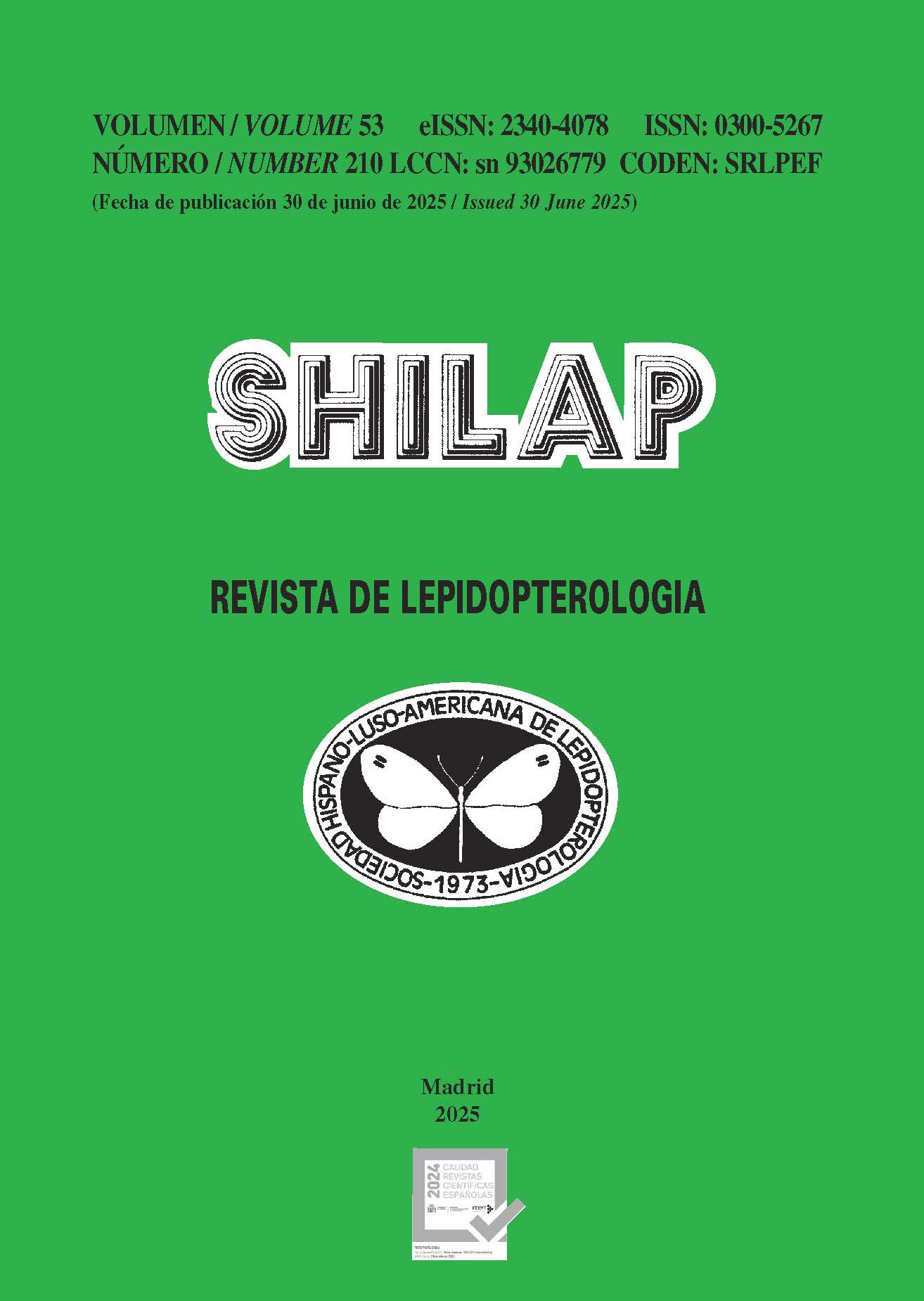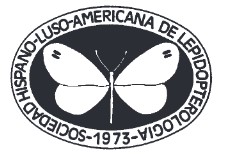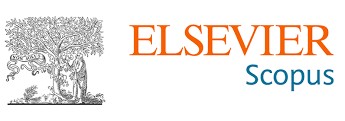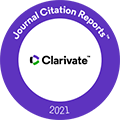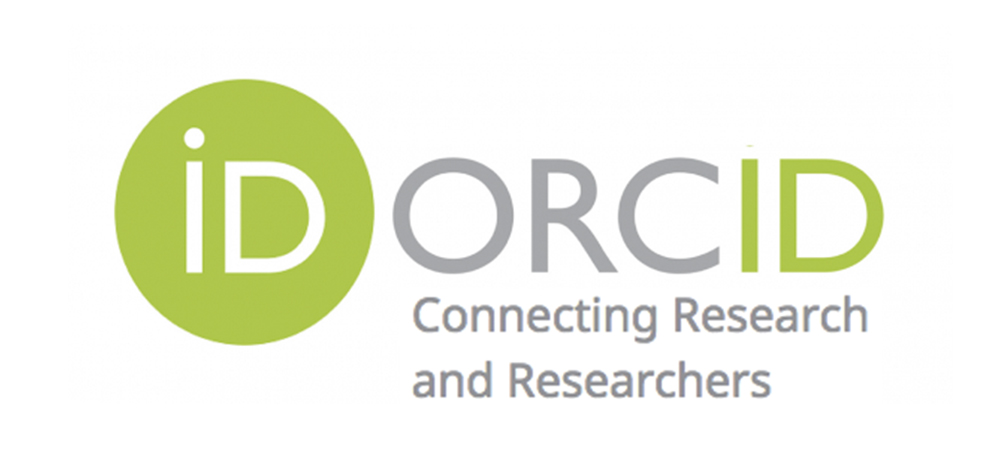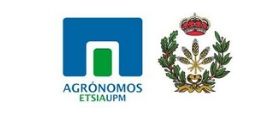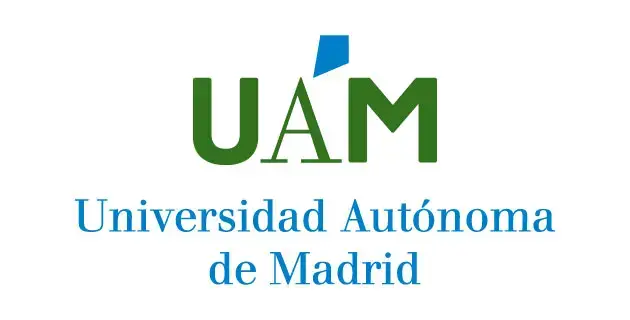Phylogeography and genetic relationship within Erebia neriene (Böber, 1890) in eastern Asia inferred from mitochondrial DNA sequences (Lepidoptera: Nymphalidae)
DOI:
https://doi.org/10.57065/shilap.1059Palavras-chave:
Lepidoptera, Nymphalidae, Erebia, COI, gene flow, glaciation, long-distance migration, ND5, AsiaResumo
Little is known about the genetic relationships within Erebia neriene (Böber, 1890) complexes inhabiting areas outside the Japanese Archipelago. In this study, we investigated genetic variations in E. neriene individuals collected from eastern Asia using mitochondrial sequences to reveal the phylogeny and genetic relationships among E. neriene complexes inhabiting areas outside the Japanese Archipelago. This study revealed greater genetic differentiation and a clear genetic structure among E. neriene neriene and E. neriene scoparia (Butler, 1882) populations. This is the first population genetics study of these subspecies.
Downloads
Estatísticas globais ℹ️
|
401
Visualizações
|
90
Downloads
|
|
491
Total
|
|
Referências
Benjamini, Y., & Yekutieli, D. (2001). The control of the false discovery rate in multiple testing under dependency. Annals of Statistics, 29(4), 1165-1188. https://doi.org/10.1214/aos/1013699998 DOI: https://doi.org/10.1214/aos/1013699998
Bromilow, S. M., & Sperling, F. A. H. (2011). Phylogeographic signal variation in mitochondrial DNA among geographically isolated grassland butterflies. Journal of Biogeography, 38(2), 299-310. https://doi.org/10.1111/j.1365-2699.2010.02398.x DOI: https://doi.org/10.1111/j.1365-2699.2010.02398.x
Excoffier, L., & Lischer, H. E. L. (2010). Arlequin suite ver 3.5: a new series of programs to perform population genetics analyses under Linux and Windows. Molecular Ecology Resources, 10(3), 564-567. https://doi.org/10.1111/j.1755-0998.2010.02847.x PMid:21565059 DOI: https://doi.org/10.1111/j.1755-0998.2010.02847.x
Frenzel, B. (1968). The pleistocene vegetation of Northern Eurasia. Science, 161(3842), 637-649. https://doi.org/10.1126/science.161.3842.637 PMid:17801456 DOI: https://doi.org/10.1126/science.161.3842.637
Honda, K., Honda, Y., Matsumoto, J., Tsuruta, Y., Yagi, W., Ômura, H.. & Honda, H. (2016). Production and sex-pheromonal activity of alkaloid-derived androconial compounds in the danaine butterfly, Parantica sita (Lepidoptera: Nymphalidae: Danainae). Biological Journal of the Linnean Society, 119(4), 1036-1059. https://doi.org/10.1111/bij.12823 DOI: https://doi.org/10.1111/bij.12823
Inomata, T., Uémura, Y., Yago M., Jinbo, U., & Ueda, K. (2010-2013). The current checklist of Japanese butterlies. http://binran.lepimages.jp/. (in Japanese)
Michalakis, Y., & Excoffier, L. (1996). A generic estimation of population subdivision using distances between alleles with special refernce for microsatellite loci. Genetics, 142(3), 1061-1064. https://doi.org/10.1093/genetics/142.3.1061 PMid:8849912 PMCid:PMC1207006 DOI: https://doi.org/10.1093/genetics/142.3.1061
Nagaoka, H., & Xiaoshuan, B. (2017). Butterflies survey in north region of Inner Mongolia, the People’s Republic of China. Yadoriga, 252, 36-50. (in Japanese)
Nakatani, T., Ueda, S., Nishio, S., & Usami, S. (2018). Molecular phylogeny of the genus Erebia (Lepidoptera, Nymphalidae, Satyrinae): species groups inferred from mitochondrial and nucleus gene sequences. Butterfly Science, 12, 27-48.
Nakatani, T., Usami, S., & Itoh, T. (2007a). Molecular phylogenetic analysis of the Erebia aethiops group (Lepidoptera, Nymphalidae). Transaction of the Lepidopterological Society of Japan, 58(4), 387-404.
Nakatani, T., Usami, S., & Itoh, T. (2007b). Phylogeographic history of hte Japanese alpine ringlet Erebia niphonica (Lepidoptera, Nymphalidae): fragmentation and secondary contact. Transaction of the Lepidopterological Society of Japan, 58(3), 253-275.
Nei, M., & Li, W.-H. (1979). Mathematical model for studying genetic variation in terms of restriction endonucleases. Proceedings of the National Academy of Sciences of the United States of America, 76(10), 5269-5273. https://doi.org/10.1073/pnas.76.10.5269 PMid:291943 PMCid:PMC413122 DOI: https://doi.org/10.1073/pnas.76.10.5269
Schmitt, T., & Haubrich, K. (2008). The genetic structure of the mountain forest butterfly Erebia euryale unrabels the late Pleistocene and postglacial history of the mountain coniferous forest biome in Europe. Molecular Ecology, 17(9), 2194-2207. https://doi.org/10.1111/j.1365-294X.2007.03687.x PMid:18266631 DOI: https://doi.org/10.1111/j.1365-294X.2007.03687.x
Schmitt, T., Hewitt, G. M., & Muller, P. (2006). Disjunct distributions during glacial and interglacial periods in mountain butterflies: Erebia epiphron as an example. Journal of Evolutionary Biology, 19(1), 108-113. https://doi.org/10.1111/j.1420-9101.2005.00980.x PMid:16405582 DOI: https://doi.org/10.1111/j.1420-9101.2005.00980.x
Sekiguchi, M., Nakatani, T., Shinkawa, T., & Kogure, M. (2002). Molecular phylogenetic analysis of hte genus Erebia. Transaction of the Lepidopterological Society of Japan, 53(1), 1-11. https://doi.org/10.1665/1082-6467(2002)011[0001:AMPAOT]2.0.CO;2 DOI: https://doi.org/10.1665/1082-6467(2002)011[0001:AMPAOT]2.0.CO;2
Simon, C., Frati, F., Beckenbach, A., Crespi, B., Liu, H., & Flook, P. (1994). Evolution, weighting and phylogenetic utility of mitochondrial gene sequences and a compilation of conserved polymerase chain reaction primers. Annals of the Entomological Society of America, 87(6), 651-701. https://doi.org/10.1093/aesa/87.6.651 DOI: https://doi.org/10.1093/aesa/87.6.651
Tamura, K., Stecher, G., & Kumar, S. (2021). MEGA 11: molecular evolutionary genetics analysis version 11. Molecular Biology and Evolution, 38(7), 3022-3027. https://doi.org/10.1093/molbev/msab120 PMid:33892491 PMCid:PMC8233496 DOI: https://doi.org/10.1093/molbev/msab120
Yagi, T., Sasaki, G., & Takebe, H. (1999), Phylogeny of Japanese papilionid butterflies inferred from nucleotide sequences of mitochondrial ND5 gene. Journal of Molecular Evolution, 48(1), 42-48. https://doi.org/10.1007/PL00006443 PMid:9873075 DOI: https://doi.org/10.1007/PL00006443
Downloads
Publicado
Como Citar
Edição
Secção
Licença
Direitos de Autor (c) 2025 Hisato Nagaoka, Xiaoshuan Bai, Dmitry Goshko, Batzorig Baljinnyam, Toshiaki Yamamoto, Kaneaki Edo, Shigeru Kitanishi

Este trabalho encontra-se publicado com a Licença Internacional Creative Commons Atribuição 4.0.
O autor mantém os seus direitos de marca registada e de patente para qualquer processo ou procedimento dentro do artigo.
O autor mantém o direito de partilhar, distribuir, executar e comunicar publicamente o artigo publicado no SHILAP Revista de lepidopterología, com reconhecimento inicial da sua publicação no SHILAP Revista de lepidopterología.
O autor reserva-se o direito de fazer uma publicação posterior da sua obra, desde a utilização do artigo até à sua publicação num livro, desde que indique a sua publicação inicial no SHILAP Revista de lepidopterología.
Cada apresentação ao SHILAP Revista de lepidopterología deve ser acompanhada por uma aceitação dos direitos de autor e reconhecimento da autoria. Ao aceitá-los, os autores retêm os direitos autorais da sua obra e concordam que o artigo, se aceite para publicação pelo SHILAP Revista de lepidopterología, será licenciado para uso e distribuição sob uma licença "Creative Commons Attribution 4.0 International" (CC BY 4.0), que permite a terceiros partilhar e adaptar o conteúdo para qualquer fim, dando o devido crédito à obra original.
Pode consultar aqui a versão informativa e o texto legal da licença. A indicação da licença CC BY 4.0 deve ser expressamente indicada desta forma quando necessário.
A partir de 2022, o conteúdo da versão impressa e digital é licenciado sob uma licença de utilização e distribuição "Creative Commons Attribution 4.0 International" (CC BY 4.0), que permite a terceiros partilhar e adaptar o conteúdo para qualquer fim, dando o devido crédito à obra original.
O conteúdo anterior da revista foi publicado sob uma licença tradicional de direitos de autor; no entanto, o arquivo está disponível para acesso livre.
Ao utilizar o conteúdo do SHILAP Revista de lepidopterología publicado antes do ano 2022, incluindo figuras, tabelas ou qualquer outro material em formato impresso ou eletrónico pertencem aos autores dos artigos, os autores devem obter a autorização do detentor dos direitos de autor. As responsabilidades legais, financeiras e criminais a este respeito pertencem ao(s) autor(es).
Em aplicação do Princípio de Prioridade do Código Internacional de Nomenclatura Zoológica, nenhuma outra versão além da publicada pela editora pode ser depositada em repositórios, websites pessoais ou similares.
